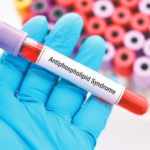At discharge, the patient received prescriptions for a prednisone taper and warfarin, while she continued taking hydroxychloroquine. After discharge, the patient’s creatinine stabilized to approximately 2.0 mg/dL.
At age 37, the patient reported shortness of breath and groundglass pulmonary infiltrates were found. Despite completing several courses of antibiotics over a few months, the dyspnea and infiltrates persisted. When hospitalized during an acute exacerbation of dyspnea, she presented with reduced hemoglobin and diffuse alveolar hemorrhage, confirmed as bronchoalveolar lavage. The patient’s breathing improved with glucocorticoids and plasmapheresis, and she received a prescription for a prednisone taper at discharge.
On referral to your clinic for further management, you added a rituximab course to her prednisone taper followed by a second round of rituximab after six months, while she continued taking warfarin and hydroxychloroquine. The patient experienced no further pulmonary hemorrhage flares, despite unchanged aPL antibody levels, but her kidney function deteriorated over the next two years. The patient is under consideration for a living-donor kidney transplant.
Key Takeaways
“IgG isotype antibodies recognizing the plasma protein beta-2 glycoprotein I are clearly pathogenic, activating a variety of effector cells to create the prothrombotic state inherent to APS,” Dr. Knight says.
“The microvascular manifestations of APS often progress despite treatment with anticoagulation, highlighting a subgroup of patients who are especially in need of new approaches to therapy.
“Rheumatologists (and patients) should feel optimistic that we are closer than we have ever been to trialing new therapeutic strategies that endeavor to impact APS closer to its antibody-mediated source,” Dr. Knight concludes.
Katie Robinson is a medical writer in New York.
Disclosures
Dr. Knight has received consulting fees from ArgenX, BioCryst, Jazz Pharma, Ouro Medicines, Roche, Roivant Sciences and Visterra/Otsuka, along with grant funding from Jazz Pharma and Visterra/Otsuka.
References
- Bucala R, Solomon DH. Immunology for the rheumatologist: Arthritis & Rheumatology introduces a new problem-based immunology review series with great educational potential. Arthritis Rheumatol. 2024 Jan;76(1):9–10.
- Newman TG, Knight JS. Antiphospholipid syndrome: An antibody-mediated disease with emerging therapeutic opportunities. Arthritis Rheumatol. 2025 May 19. Epub ahead of print.

